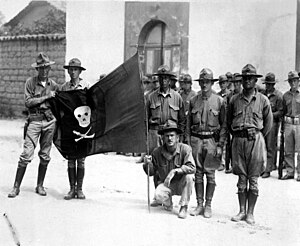| United States occupation of Nicaragua | |||||||
|---|---|---|---|---|---|---|---|
| Part of the Banana Wars | |||||||
 United States Marines with the captured flag of Augusto C. Sandino in 1932 | |||||||
| |||||||
| Belligerents | |||||||
|
|
| ||||||
| Commanders and leaders | |||||||
|
|
| ||||||
| Casualties and losses | |||||||
|
First occupation (1912–1925): 7 killed (5 marines & 2 sailors) 16 marines wounded (all in 1912)[1] Second occupation (1926–1933): 136 marines killed (32 killed-in-action, 15 died of wounds, and 5 murdered by mutinous National Guardsmen)[2] 75 killed (Nicaraguan National Guardsmen)[2] |
First occupation (1912–1925): Unknown Second occupation (1926–1933): 1,115 Sandinista insurgents killed[3] | ||||||
The United States occupation of Nicaragua from August 4, 1912, to January 2, 1933, was part of the Banana Wars, when the U.S. military invaded various Latin American countries from 1898 to 1934. The formal occupation began on August 4, 1912, even though there were various other assaults by the United States in Nicaragua throughout this period. American military interventions in Nicaragua were designed to stop any other nation except the United States of America from building a Nicaraguan Canal.
Nicaragua assumed a quasi-protectorate status under the 1916 Bryan–Chamorro Treaty. President Herbert Hoover (1929–1933) opposed the relationship. On January 2, 1933, Hoover ended the American intervention.[4]
- ^ Boot, Max (May 27, 2003). The Savage Wars of Peace: Small Wars and the Rise of American Power. New York City: Basic Books. p. 148.
- ^ a b Macaulay, Neill (February 1998). The Sandino Affair. Chicago: Quadrangle Books. p. 239.
- ^ Macaulay, Neill (February 1998). The Sandino Affair. Chicago: Quadrangle Books. pp. 239–240.
- ^ Andrew Glass, "Marines withdraw from Nicaragua, Jan. 2, 1933" Politico (2019) [1]